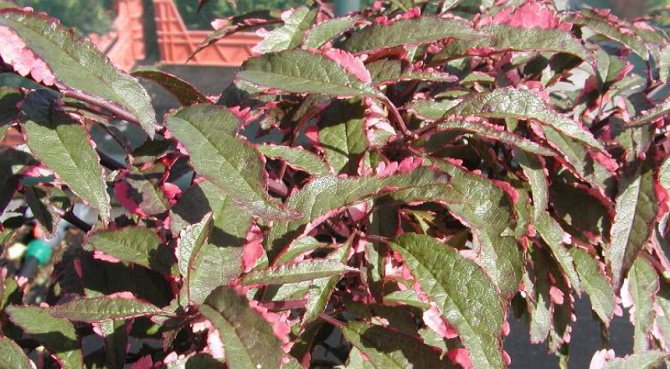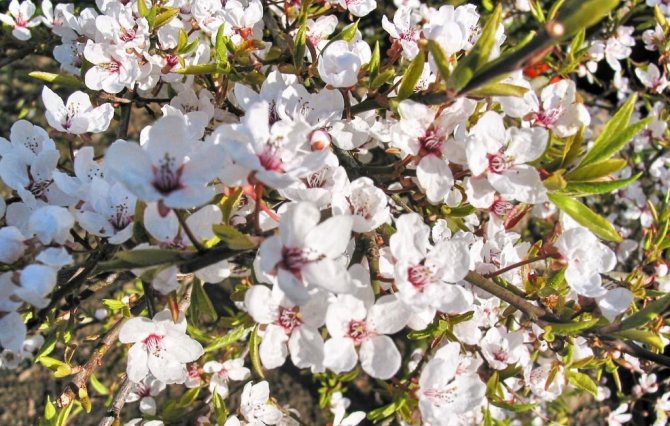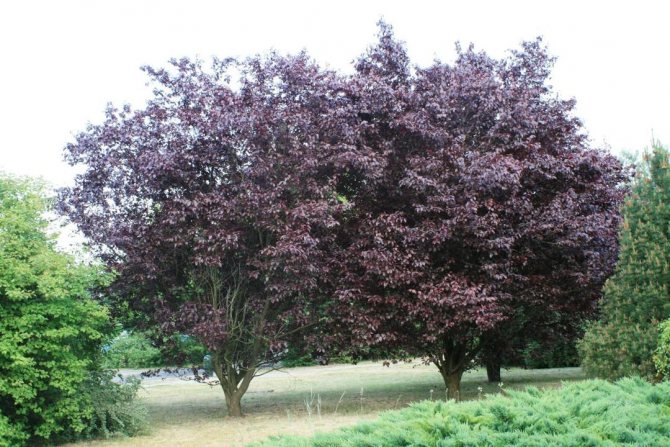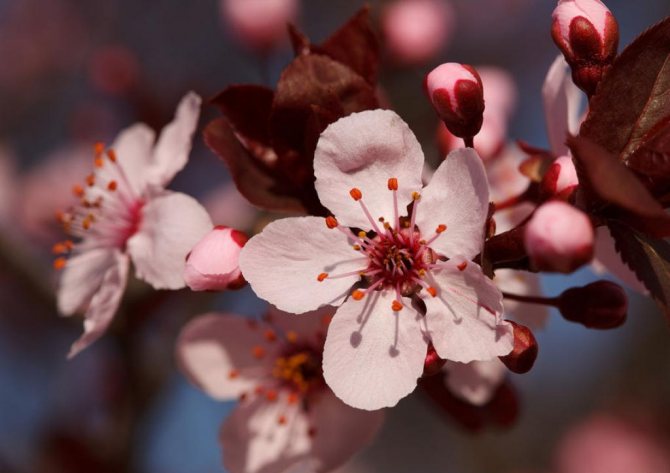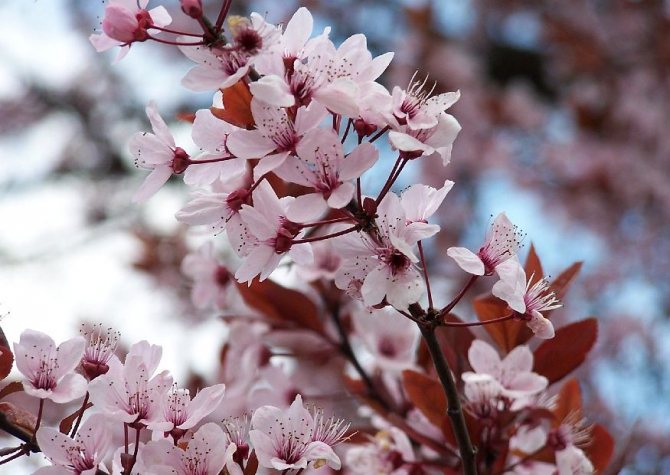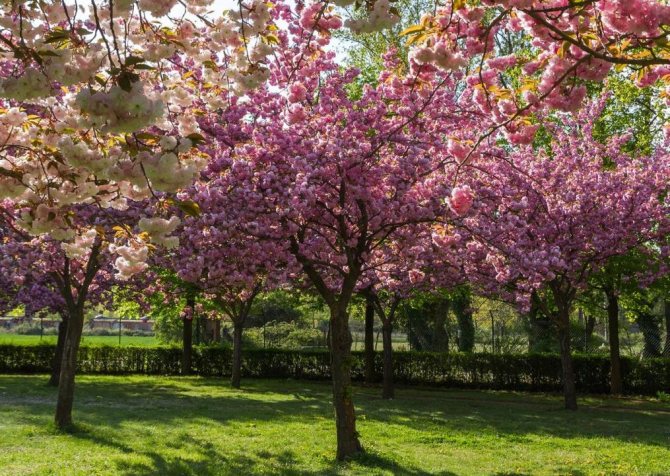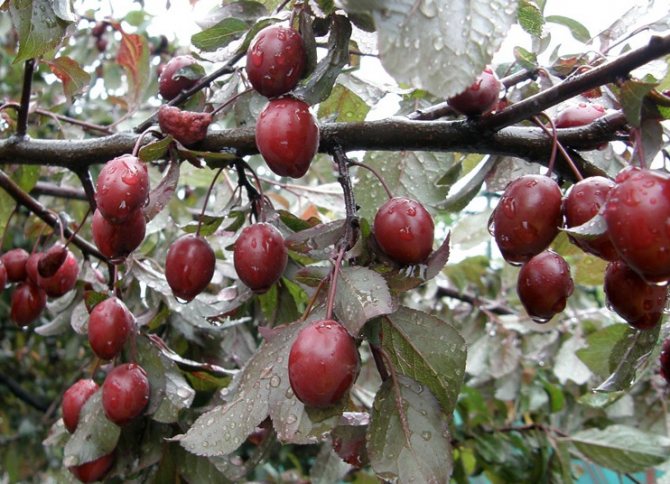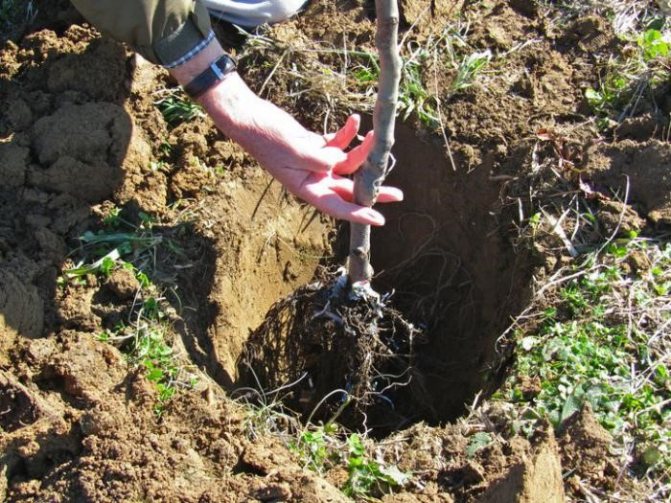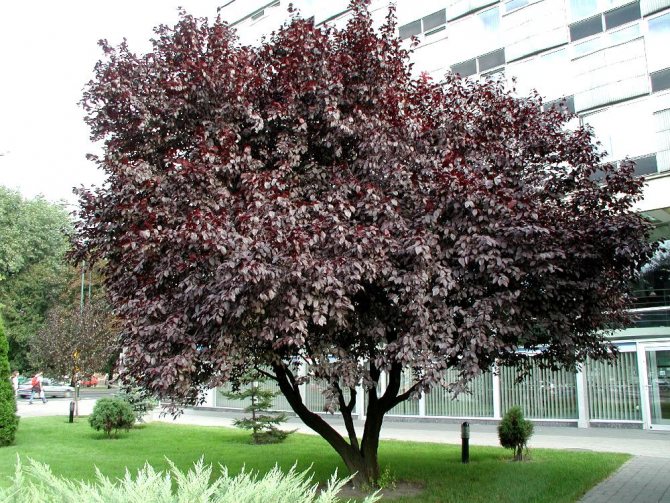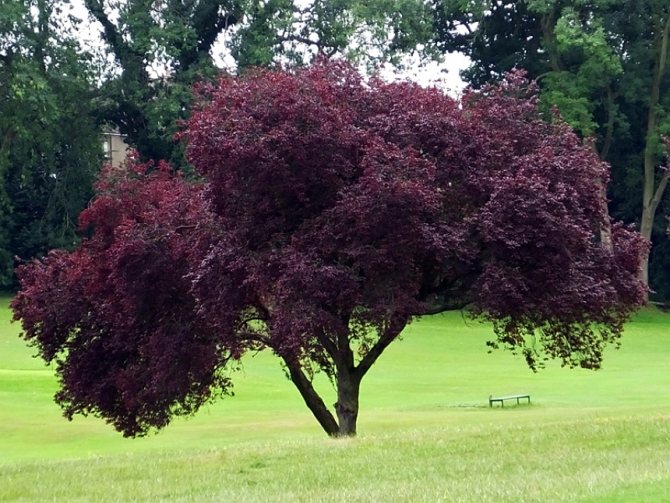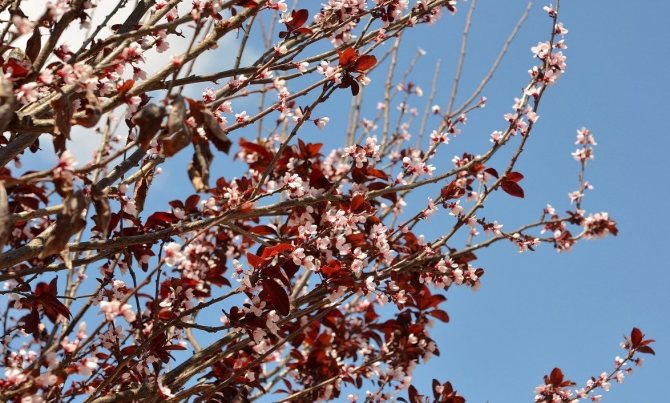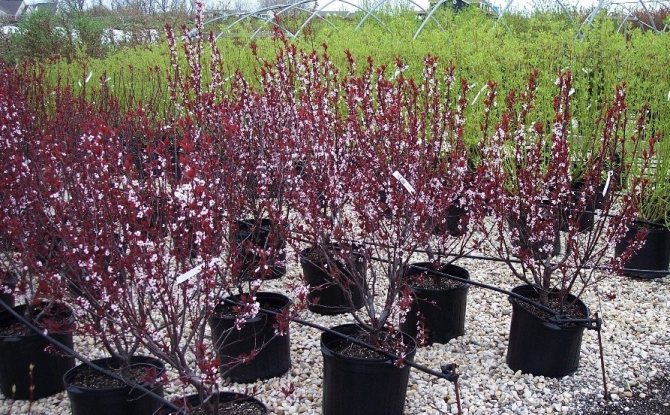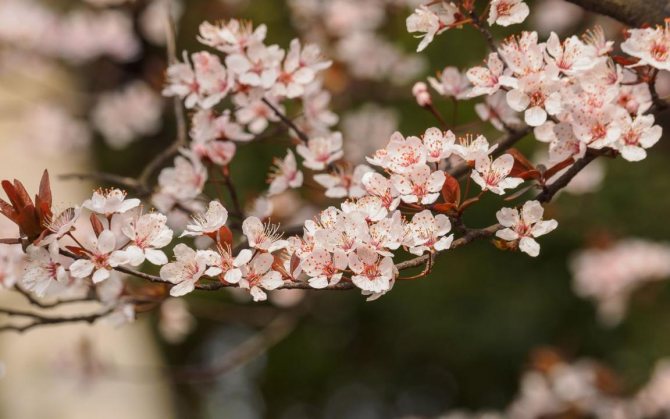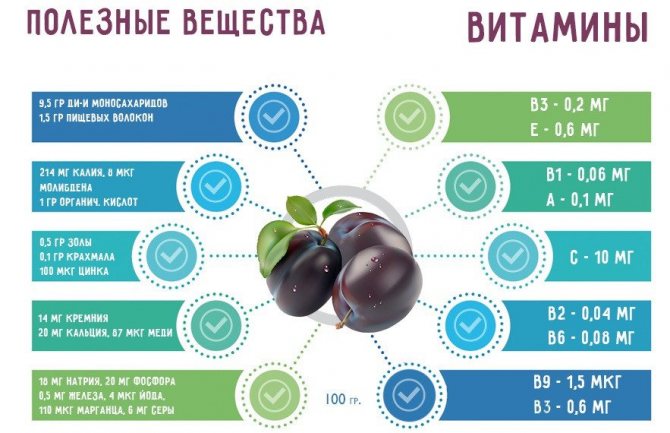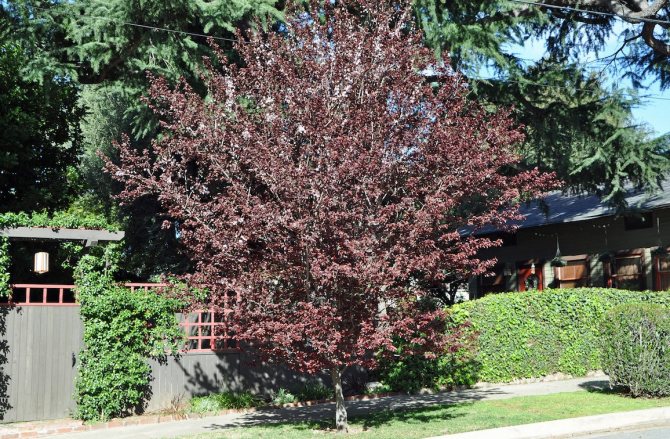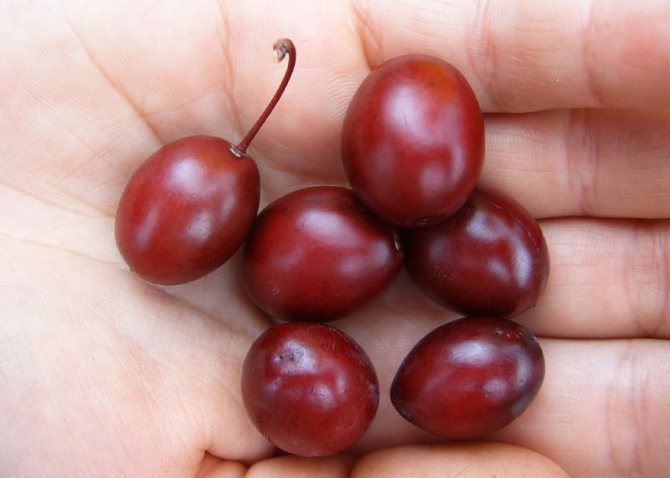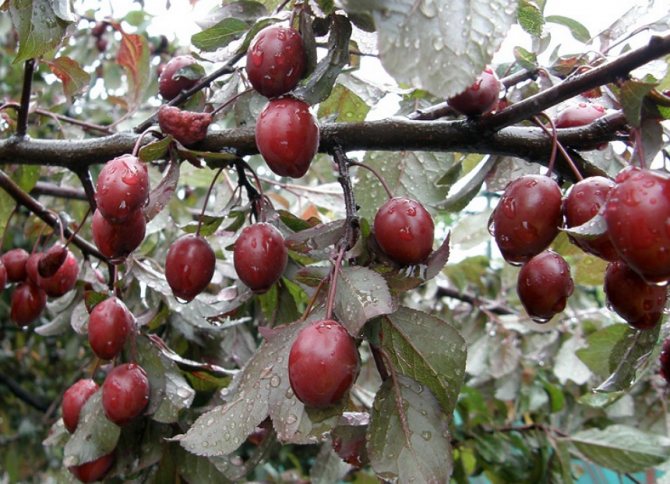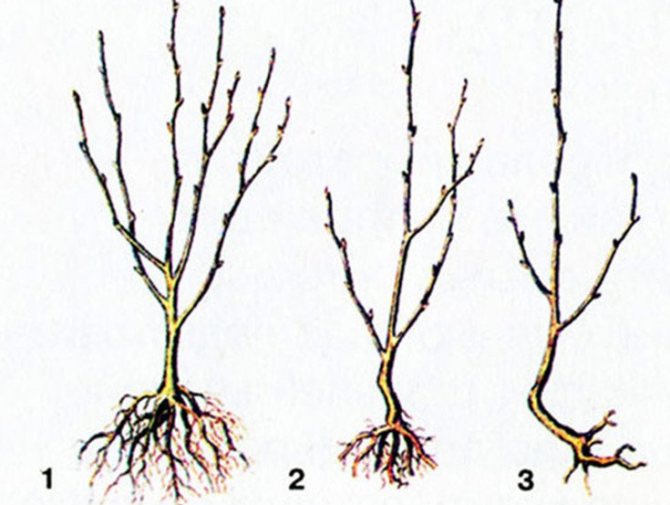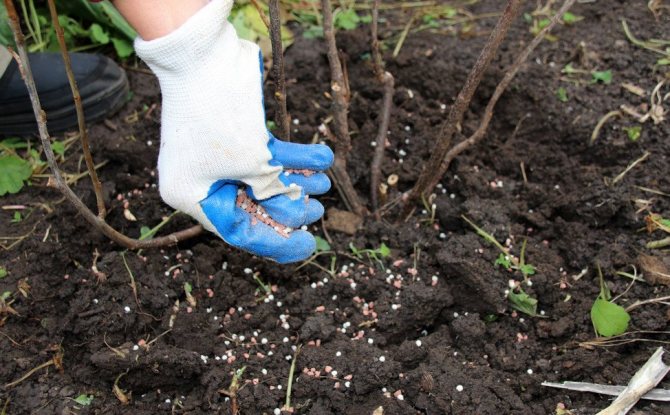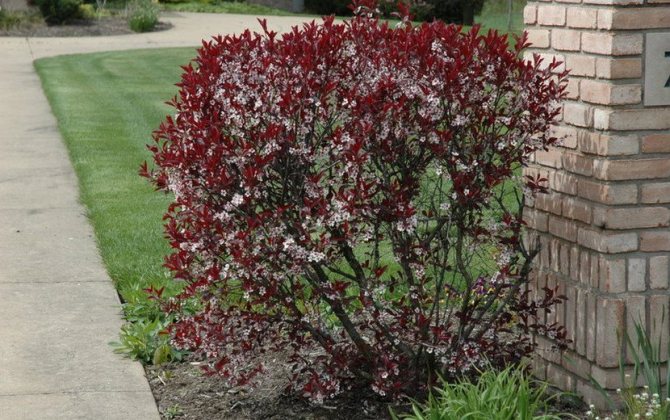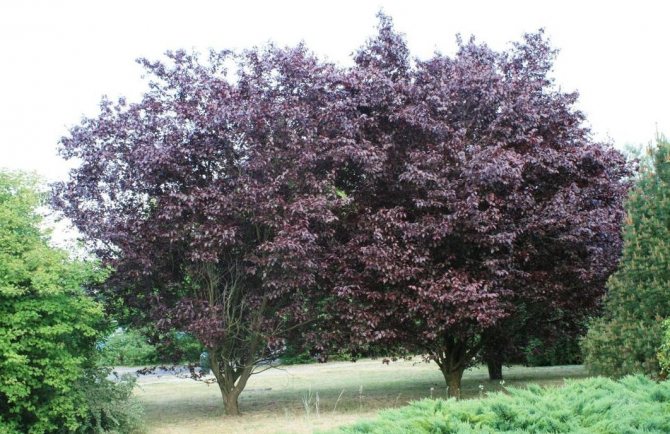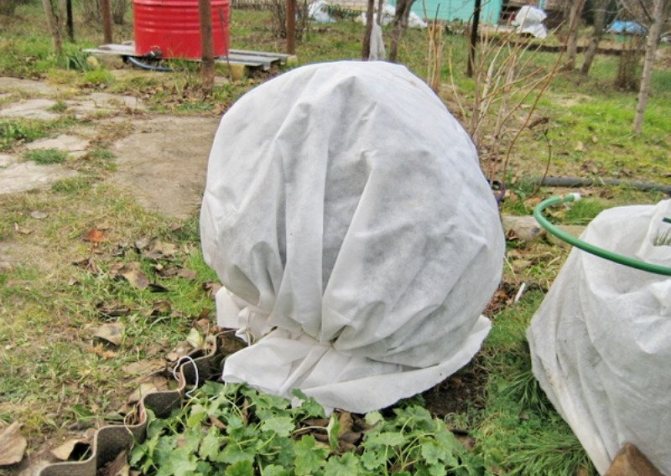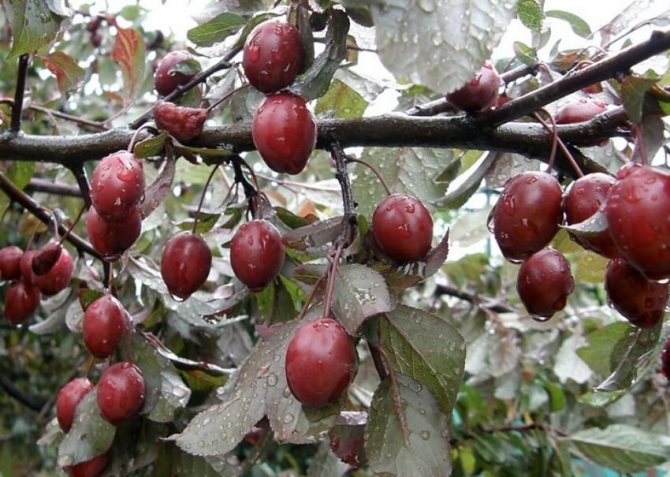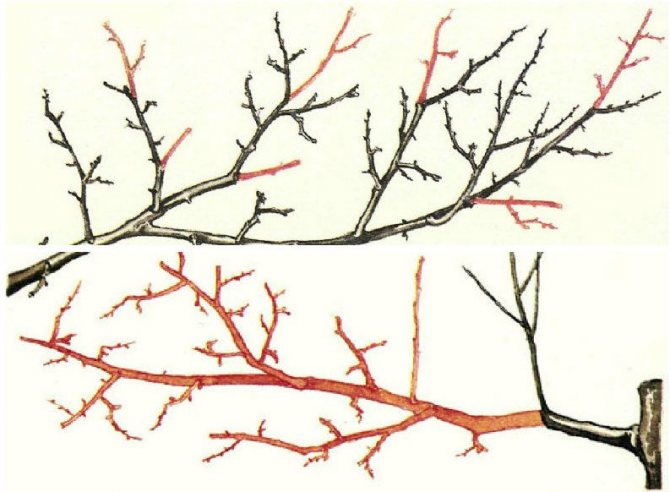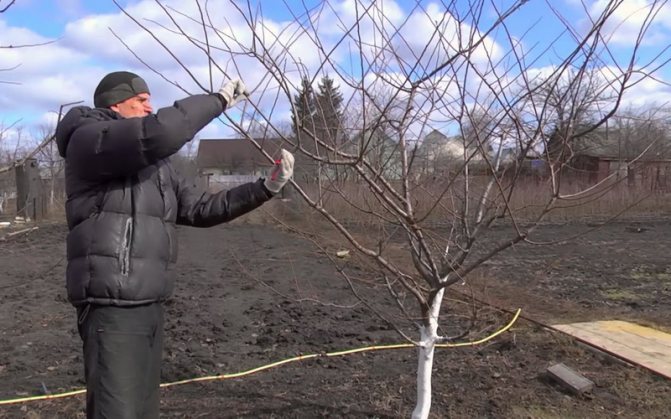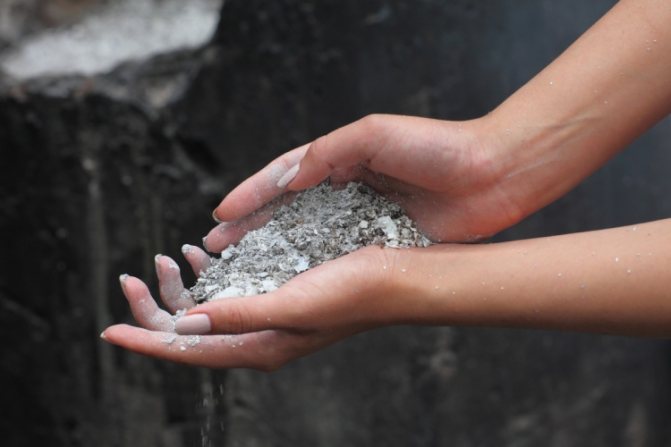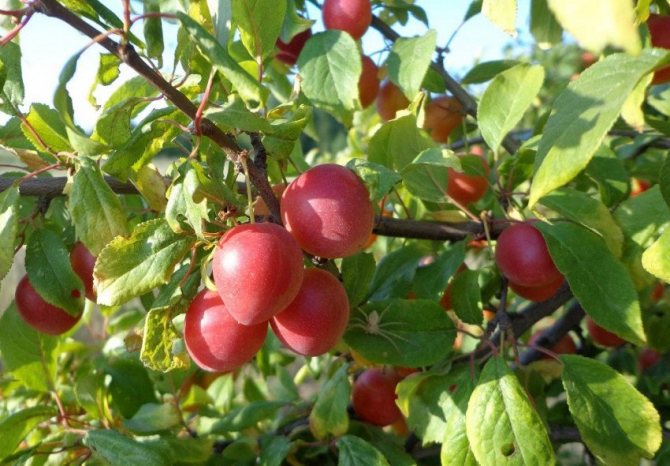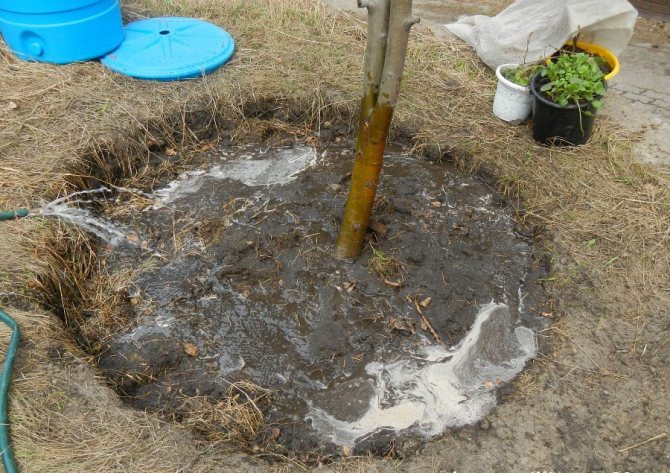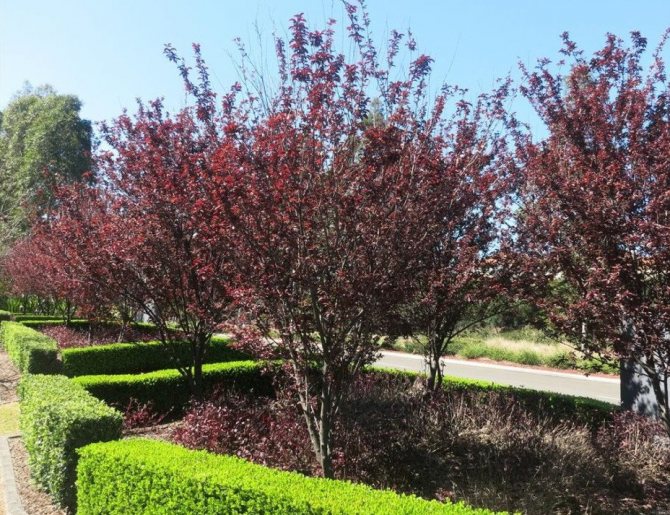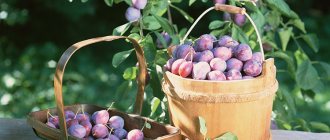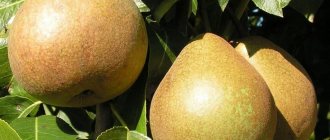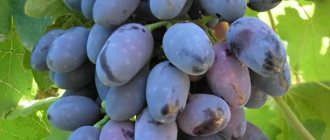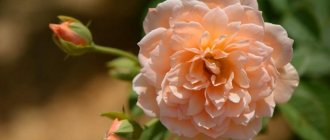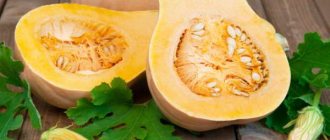Meet the decorative plum with red leaves
When choosing the first trees for their garden, most gardeners do not think about their appearance - delicious fruits play the main role. However, over time, there is a need for beauty - and then the decorative red-leaved plum comes to the rescue.
Ornamental plum leaves are not green, like most trees, but a deep red-purple color. Therefore, in the garden, the plant plays the role of a bright accent. If a decorative plum with red leaves is chosen high and spreading, then it stands out against the background of other trees, and if it is squat and undersized, it can border them or serve as a hedge.
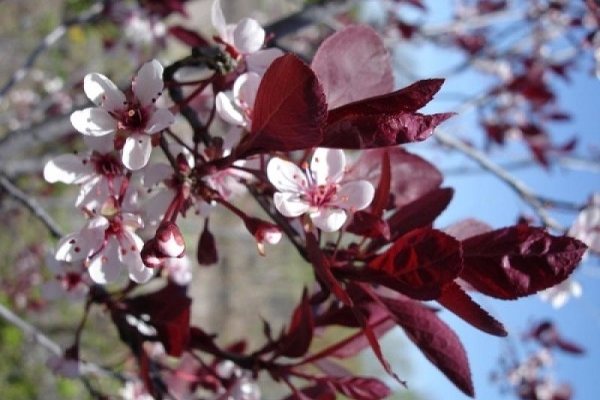
Application in landscape design
Due to the original color of the foliage, the Pissardi variety is widely used in landscape design to create landscape compositions, as a contrasting plant. Culture looks especially impressive on a green background.
This variety is widely used for landscaping the city, gardens in the oriental style, creating landscape color compositions and alleys.
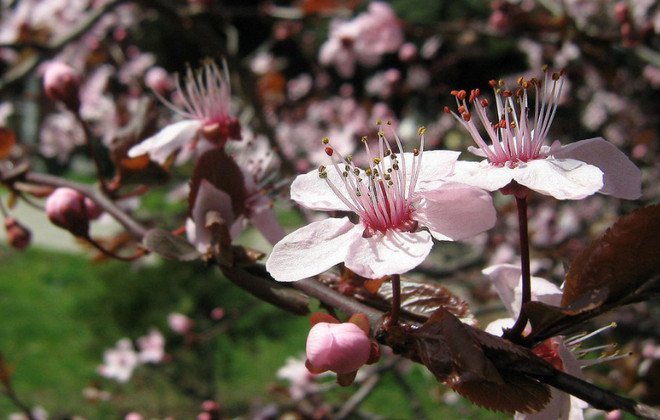

"Pissardi" is an integral component of single and group plantings. Cherry plum looks especially attractive in compositions with acacia and cypress.
Line of hybrids "Russian plum"
Especially popular in the middle lane are varieties of the decorative Russian plum, obtained from crossing the southern cherry plum with the Ussuri or Chinese plum.
Scarlet Sails
The red-leaved plum of this variety is a tree up to 4 - 5 m in height, with a thinned but spreading crown, with large leaves of deep red color. The plum with red leaves and dark pink flowers bears fruit in mid-August. Scarlet sails have a dark crimson color and average weight - each fruit weighs about 25 g.
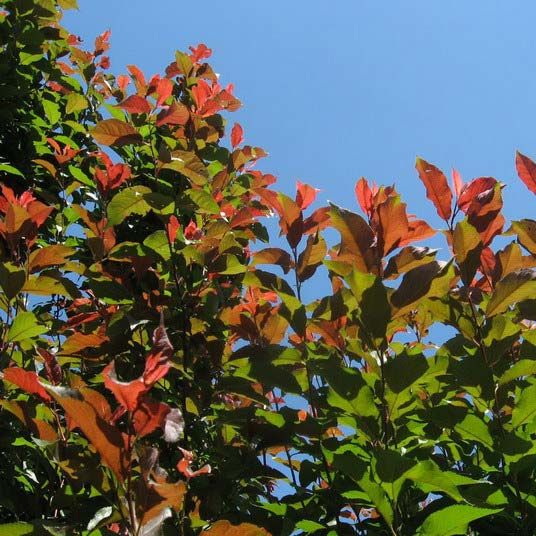

Among the advantages of Scarlet Sails are high resistance to negative temperatures and drought, low susceptibility to fungal diseases. The tree gives bountiful harvests and bears fruit every year, however, it belongs to the category of self-fertile. For Scarlet Sails, pollinators can be the Chinese plum varieties Skoroplodnaya and Krasny Ball, as well as the cherry plum Melnaya.
Llama
This decorative variety of Russian plum differs in its small size - 1.3 - 2 m. The crown is round-flat, dense, dark red leaves throughout the summer period. A plum with pink flowers produces large raspberry fruits, each of which can weigh up to 40 g.
The red-leaved variety Lama was bred specifically for cultivation in the middle lane, therefore it calmly tolerates frosts up to -35 degrees. The shoots of the tree are not afraid of light spring frosts, the variety has increased resistance to pests and diseases.
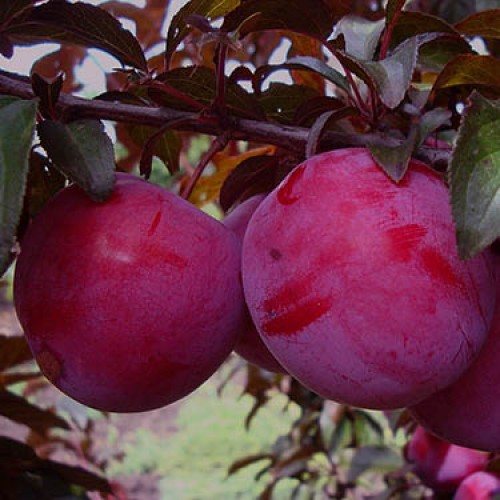

Llama is a self-fertile ornamental plum, so pollinators are required for high annual yields. For this variety, Chinese plums and cherry plums with flowering in mid-May are well suited - for example, Vitba, Mara and Asaloda.
Early
Russian plum Rannaya is a large tree up to 7 m in height with a rounded crown, large red leaves with jagged edges and a brown underside of the leaf. It has equally good resistance to frost, disease and pests, and brings abundant harvests from dark red fruits.
The tree, like most plum varieties, is self-fertile, therefore it requires pollinators, for the role of which cherry plums and Chinese plums with early flowering are ideal.
Nigra
Another red-leaved decorative variety is Nigra, a short tree with an oval crown. Young leaves are ruby in color, adults are dark purple. The red-leaved plum blooms with pink flowers in late April or early May, even before foliage appears on the branches. In late August, it bears dark red round fruits.
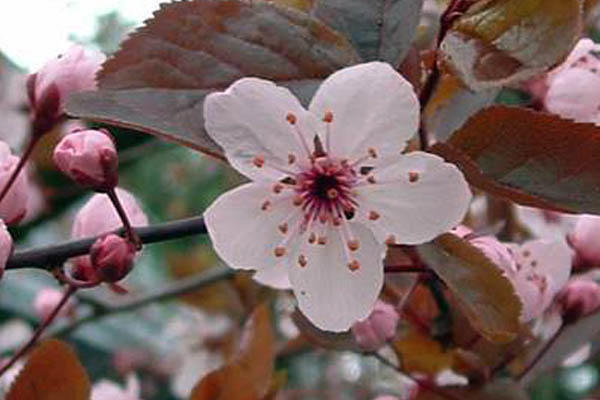

It tolerates frosts below -30 degrees and summer drought well, does not break in the wind, rarely suffers from diseases typical of fruit trees. A pollinator for a variety can be Eurasia plum or home Hungarian.
Testimonials
Alexey Leontyev, Rostov Region We used the Pissardi plum as an excellent addition to a hedge in the country. It contrasted well with other evergreen shrubs. At first, they did not attach much importance to the fruits of the plant. A few years after planting, small fruits were found on the branches of a plum. Taste for an amateur. Our family loved it. The wife closes the delicious jam. One variety performs two functions: decorative, fruit. Very comfortably. I recommend this view to everyone. Elizaveta Marchenko, Moscow Region The dacha was inherited from her grandmother. There have already been numerous landings. Among them is the Pissardi plum. I have little experience in gardening. I looked at the tree care algorithm on the Internet. The plant seemed very moody. I was afraid not to cope. In practice, it turned out that leaving is absolutely not laborious, does not require large expenditures in time and money. The variety grows quickly, pleases with a bountiful harvest. I recommend the Pissardi plum near Moscow.
Some plums are grown not only for the sake of delicious fruits, but also to decorate the garden, because these trees are very decorative throughout the season. See for yourself.
In many countries, plum is one of the most spectacular spring-flowering plants. In China, the five petals of the flower of this tree symbolize good luck, longevity, joy and peace. In our gardens, homemade plums are most often grown for the sake of juicy fruits, but decorative species are not widespread. But in vain!
Ornamental plums are perfect for decorating a Japanese-style garden. In addition, they are very winter-hardy, which is important for the unstable climate of the middle zone.
Plum spread out
The spreading plum belongs to the category of red-leaved trees of high and medium growth with abundant and fast fruiting - the first harvests from it are harvested already 2 years after planting. Typically, the spreading plum varieties are designed to be grown in warm climates.
Hesei
A shrub variety of red-leaved plum called Hesei, it produces foliage of the usual green color at first - but then the leaves turn purple, with a pink or cream border around the edges. The variety blooms with white flowers at the end of April, before the foliage blooms or simultaneously with it. Bears sweet and sour small red fruits.
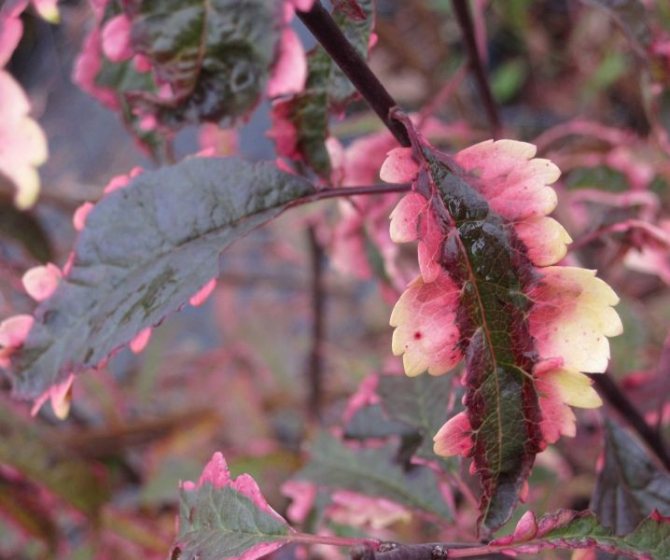

The variety is characterized by low frost resistance and tolerates negative temperatures only up to - 28 degrees. Of the diseases, black or perforated spotting remains dangerous for him. To obtain fruit, it is necessary to plant spread-out plums nearby with similar flowering times.
Pissardi
Iranian plum variety up to 6 m in height with dark purple leaves and red shoots. Pissardi is an ornamental plum with pink flowers that blooms in early spring before the foliage blooms. In August, it produces abundant pink fruits - provided that other varieties of spreading red-leaved plum were planted nearby for pollination with flowering at the end of April.
The frost resistance of the Pissardi variety is not very high - from - 20 to - 28 degrees.But the tree is highly resistant to disease.
Cisten
This ornamental variety was obtained by breeding the sand cherry and red-leaved Pissardi plum. The dwarf plant grows only up to 2 m, and at the same time it grows very slowly, so the Cisten plum is more often referred to as shrubs with a columnar crown. The leaves are elongated-rounded and toothed, dark purple on the underside and red-purple on top.
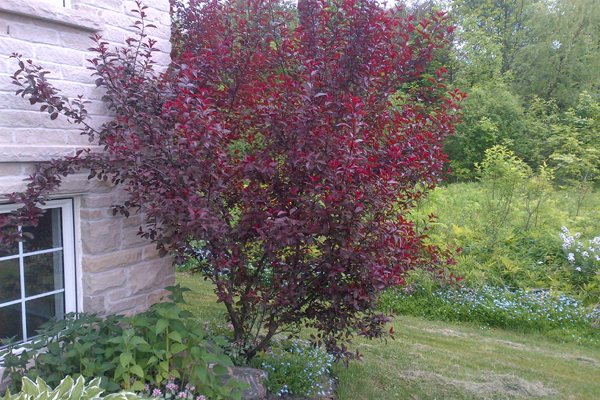

The red-leaved Cistena blooms in early spring with white flowers with a red core, and at the end of summer it bears fruit - dark purple small drupes. If you plant other varieties of low red-leaved plums nearby, Cistena will delight you with bountiful harvests.
The frost resistance of the variety is low, therefore it is not recommended to breed Cistena in cold regions. But the variety is quite resistant to diseases and pests.
Landing rules
Plum spreading is best planted in the spring, before the buds swell. You can also plant in the fall, before the first frosts come. The optimal spring time is April, autumn is mid-September.
Did you know? The life of the Pissardi tree lasts an average of 100 years.
Plum is planted in the southern part of the site. Experienced gardeners generally recommend planting a crop separately from other plants, since it does not like the neighborhood.
When planting, it is important to take into account the groundwater level. It is recommended to plant the plant in an area where this level is at least 1.5 meters. If the groundwater is closer, then the bottom of the planting hole must be drained with expanded clay or other improvised means.
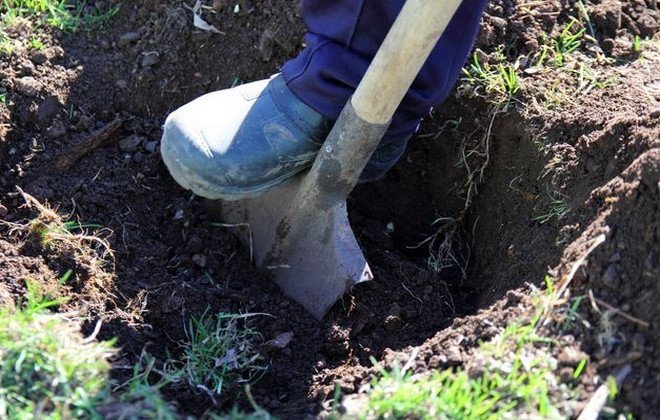

The preparation of the planting pit itself should be carried out two weeks before planting the tree. The depth of the hole should be 50 cm, width - 70 cm. The bottom of the hole of the required size is covered with a substrate of fertile soil and humus. After that, you need to install the landing stake.
On the north side of the stake, place a seedling so that the root collar is 3-5 cm higher from the ground level. After placing the seedling in the hole, its root system must be sprinkled with a fertile substrate. The pit is filled up and lightly tamped.
The final touch to the planting stage is to tie the seedling to a peg, water and mulch the soil abundantly.
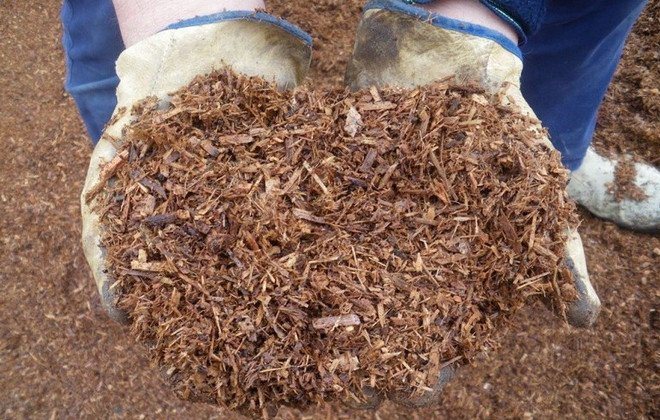

Important! The distance between the seedlings of this culture should be 2 meters. Between the seedling and other plants - so that the "neighbors" do not shade the young plum tree. Therefore, it is necessary to calculate the distance based on the height of neighboring crops.
Plum decorative purple-leaved: photo + description
To decorate the garden, a decorative purple-leaved plum is ideal - a shrub that reaches 1.5 in height, with elongated lanceolate leaves. At the very beginning, the foliage of the plum shrub has a dark red color, then, as it grows, it can turn to a dark brown hue. The decorative purple-leaved plum produces white or light pink flowers simultaneously with the appearance of foliage, and at the end of September it bears a harvest of dark red fruits.


It is best to plant plums in calm, sunny places, in well-drained, slightly alkaline or acidified soil. The bush has high winter hardiness.
Red-leaved plum variety "Hollywood"
One of the most popular red-leaved varieties is Hollywood. The plum tree reaches several meters in height, has a spreading sparse crown, which is formed by dark red shoots and red leaves. Blossoms Hollywood white flowers. Not only the appearance of the plant is attractive, which can be appreciated by the photo of a plum with red leaves. The variety also bears fruit with purple-red tasty fruits in mid-August.
Hollywood enters the yield period 5 years after planting, gives juicy and sweet fruits.The best pollinators for the self-infertile variety will be the collective farm Renklod and the Mirnaya plum.


Important! The Hollywood variety has good winter hardiness, tolerates a lack of moisture well and is not susceptible to fungal diseases.
Diseases and prevention
Plum diseases include:
- perforated spot (clasterosporium);
- milky shine and false milky shine;
- moniliosis;
- gray rot;
- marsupial disease;
- plum pockets;
- coccomycosis;
- brown fruit mite;
- slimy sawfly;
- dr.
For prevention, pruning is carried out, crown formation: removal of dry and crooked branches. A visual inspection of the plants will allow you to notice the places damaged by the disease at an early stage and prevent the spread of the infection throughout the entire area.
Diseased areas (branches, leaves) are cut and burned. They should not be put into the silo pit so that the disease does not flare up again.
The nuances of growing decorative plums
Plum varieties with burgundy leaves can be quite different from each other - it is quite difficult to form uniform care rules for them. But general nuances still exist.
- Decorative plums do not like excessively waterlogged soil; it is better to plant them in soil with a neutral acidity level.
- Before planting in the seedling hole, it is necessary to apply organic fertilizers - humus and superphosphate, which will feed the plant in the first 3 years of life.
- After entering the season of productivity, red-leaved plums are regularly fed with mineral fertilizers and organic matter. In the spring, it is necessary to apply nitrogen fertilizers, in the summer - a solution of mullein and potassium. In autumn, the earth around trees and shrubs is dug up and also flavored with humus.
- Watering decorative plums is necessary as needed - the soil should not be allowed to dry out. Usually, once every 1 - 2 months with moderate precipitation, it brings 4 - 5 buckets of water under the roots.
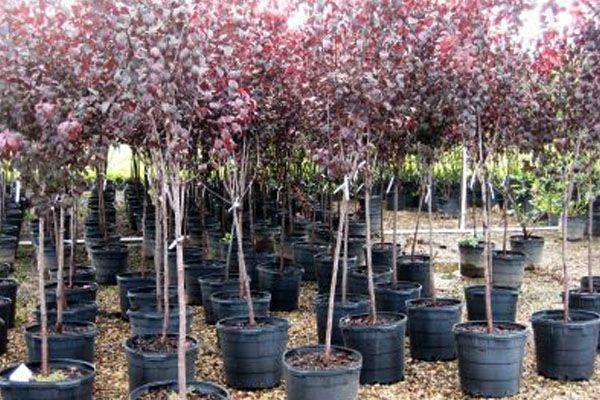

An ornamental plum with red leaves must be pruned annually. Red-leaved trees, and in particular shrubs, tolerate cutting well; they give their crowns a rounded, sparse or vase-like shape.
Attention! Decorative red-leaved plums also require sanitary pruning - timely removal of all dry and weakened parts. Otherwise, the plant may suffer from diseases and pests.
Further care
Plum care is simple. It is important to observe just a few points:
Watering and feeding
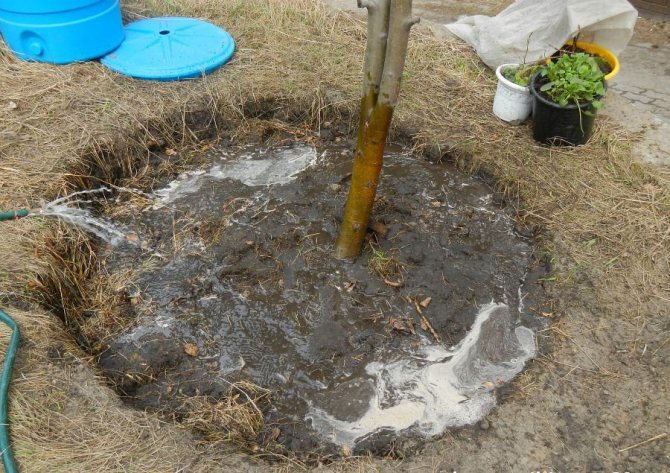

Watering the plum
Plum Red Ball
Despite the high level of drought tolerance in the red-leaved plum, adequate irrigation will not be superfluous. It is held as weekly as possible. For each tree, 40-60 liters of warm settled water should be poured.
In the first year of cultivation, a young seedling can do without additional fertilizing. Fertilizers begin to be applied in the second year of the plant's life. So, in the spring, the purple plum is in need of sodium humate and potassium fertilizers. In the fall, it is important to add humus.
Important! For 1 m² of plots, half a bucket of organic fertilizer is used.
In the spring, nitrogen fertilizers are usually applied under the Pissardi plum, which make it possible to increase and accelerate the process of growing annual increments. The normal level of fruiting in the summer can be ensured by phosphate fertilizing. To help the plant winter better, a certain amount of potassium is added under the tree in the fall.


Plum dressing
Soil care
The root system of the Pissardi plum lies mainly in the upper soil layers, as a result of which it may need a constant supply of oxygen and moisture. It can be ensured by regular loosening of the soil. This is usually done after the next irrigation.This procedure allows you to get rid of weeds that can cause serious damage to the crop, especially in the first years of cultivation.
At the end of each watering and loosening, be sure to mulch. This procedure is additionally carried out twice more during the growing season. The first is carried out in the spring in order to accelerate the heating of the soil and the beginning of its full functioning. In this case, compost or rotted manure is used. The next additional mulching is repeated in the fall, when the first frosts begin. It will protect the root system from freezing.
Pruning


Pruning plum
Pissardi is good at both shaping and sanitary pruning. The first is carried out to give the plant a decorative appearance according to the appropriate scheme, the second - in order to remove sick, dried, severely injured stems. Both pruning is done in the spring, but diseased shoots can be cut at any time of the year.
Note! After giving the plant a decorative shape, it is necessary to promptly remove young growth, which will ruin the appearance.
Preparing for winter
The Pissardi plum does not have sufficient winter hardiness and frost resistance, therefore it is very important to prepare the plant for the winter period. This can mainly be achieved through abundant irrigation and mulch application. The stem of the tree is covered with straw, peat or special covering material, which can be purchased at specialized garden stores.
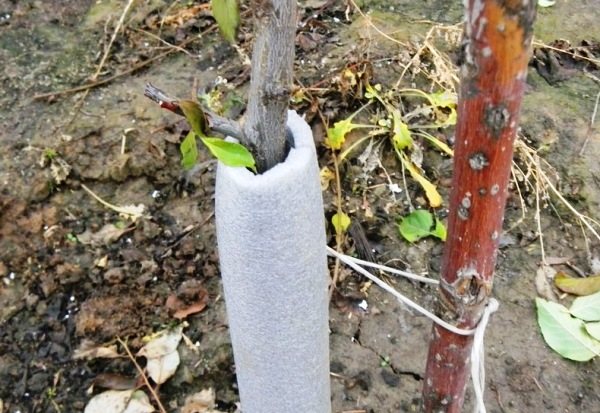

Plum shelter for the winter

